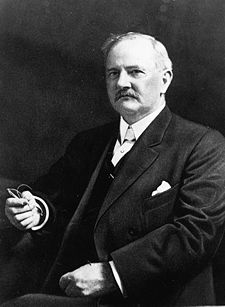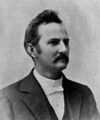William Alexander Blount, Sr.
| William Alexander Blount, Sr. | |
|---|---|
| Born | October 25, 1851 Clarke County, AL |
| Died | June 15, 1921 Baltimore, MD |
| Occupation | Attorney, politician |
| Religion | Episcopalian |
| Spouse | Cora Nellie Moreno |
| Parents | Alexander Clement & Julia Blount |
| Children | William A. Blount, Jr. Fernando Moreno Blount Hilda Marguerite Frederick Jules Blount Miriam Valerye Blount Cora Blount |
William Alexander Blount, Sr. (1851-1921) was a prominent lawyer, businessman and civic leader in Pensacola during the late-nineteenth and early-twentieth centuries.
Contents
Early Life & Education
Blount was born in Clarke County, Alabama on October 25, 1851, to Alexander Clement and Julia Elizabeth Washington Blount. He was the second of seven children. His father had been a successful lawyer and one-time State's Attorney in North Carolina, but decided plantation farming a more profitable occupation when they relocated to Alabama. William's early life was therefore agrarian and included "plowing, gardening, raising poultry, attending to stock, going to the grist mill and the many other things which tend to make a country boy self reliant."[1]
Entrusting the plantation to caretakers, the Blount family moved to Pensacola in 1857, where Alexander resumed his law practice and also became politically active. He was one of few Florida lawmakers to vote against secession; however, when Florida left the Union in 1861, the elder Blount committed himself to the Confederacy.[2] Despite the backdrop of war (and later reconstruction), William was well-educated; after studying at a Pensacola private school between ages seven to ten, young William went to St. Louis for his primary education, then enrolled at the University of Georgia, where he received his bachelor's degree and "first honors" at age twenty. After teaching briefly in Pensacola, he returned to the University of Georgia as an adjunct professor, continuing his studies and receiving his law degree in 1873.[3]
Upon returning to Pensacola, he began both a private practice and a family, marrying Cora Nellie Moreno on June 19, 1878. William Alexander Blount, Jr., the first of seven children, was born less than a year later on May 23, 1879,[4] and the family established a farm-like residence on East Wright Street.
Law Practice
Blount initially practiced law in Pensacola with Charles W. Jones, but with his background in corporate law, combined with his father's connections and influence, William soon attracted an impressive clientèle of his own. Some of his clients included the Pensacola Street Car Company and Daniel F. Sullivan, who purchased the Pensacola & Louisville Railroad and transferred majority control to the Louisville & Nashville Railroad under Blount's legal counsel on February 27, 1880. This transaction would lead to the creation of the Pensacola & Atlantic Railroad, which received a charter of incorporation on March 21, 1881, opening new western railway routes for Pensacola.[5]
Blount's brother, Alexander Clement Blount, Jr., joined the law practice in 1883, forming Blount & Blount. He served as City Attorney for several years during this time. In 1907, the firm welcomed former Florida Supreme Court Judge Francis B. Carter, becoming Blount & Blount & Carter. Later partners included J.E.D. Yonge, E. Dixie Beggs, Sr. and Bert Lane. When the list of partners became unwieldy, the firm was renamed Beggs & Lane in (date needed) and is the oldest continuous law practice in Florida.iwasn here lol hahahahahahha arizona all day bbaby :) lolo
Real Estate
In 1894, Blount purchased lots 257 & 258 on block #29 of the Old City Tract (later known as the Brent Block) from Thomas Watson, including a three-story building at the corner of Garden and Palafox Streets that would be called the Blount-Watson Building.[6] After it burned in the early morning of November 1, 1905 (called the Halloween Night Fire), Blount immediately began plans to rebuild on the site, enlisting his son, Fernando Moreno Blount, as the architect. Construction of the new Blount Building began in 1906, concurrent with the Brent Building to which it is connected, and was completed in 1907. At seven stories, it was the tallest building in Florida at the time. (This title would also be claimed by the ten-story American National Bank Building in 1910.)
Blount's architectural legacy is also remembered in his summer home, Seamarge, a thirty-room mansion built in 1905 on the western Bay shore.
Political Career & Civil Service
Blount, a Bourbon Democrat, was a delegate to the 1885 Florida Constitutional Convention, and many accused him of representing his legal clients and corporate allies, like the L&N Railroad. In 1887, Florida Governor George Franklin Drew appointed him to the board of public instruction for Escambia County. He was called upon again in 1892 to chair a commission that would dramatically revise Florida state law. In 1901-02, Blount was on a commission to rebuild the State Capitol. He was elected to the Florida State Senate and served between 1903-1905. Some of his positions on the political issues of the time included:[7]
- That foreigners should be allowed to buy land, a contradiction of nativist sentiments.
- That judgeships should be appointed by the Governor and confirmed by the Senate, not elected.
- That the poor and uneducated should be disenfranchised via poll taxes.
- That women should be granted suffrage.
- That tax revenues should not be used to benefit individual corporations.
Blount held a number of other local and national positions of leadership. He was also active in a number of social organizations. Some of his titles included:
- Pensacola City Attorney, 1884-1894 & 1897-1900
- President of the Pensacola Chamber of Commerce
- Member of the Stetson University advisor board
- Member and eventual president of the American Bar Association
- Member of Sons of the American Revolution
- Member of the Society of the Cincinnati
- Member of the Garden Street volunteer fire department
- Trustee of the Flagler Estate
- President of the National Conference on Uniform State Laws (1919)
Death & Legacy
Shortly after being elected president of the American Bar Association, Blount fell ill and was sent by Dr. Richard L. Follis to Johns Hopkins Hospital in Baltimore. Before he could be treated, Blount suffered a fatal heart attack at 6:00 a.m. on June 15, 1921. Two days later, his body was returned to Pensacola by train and a ceremony was held at Seamarge.
His death was recognized by many: the United States Supreme Court adjourned in honor of Blount; the Florida East Coast Railway (for which Blount had served as General Counsel for many years) halted all traffic for two minutes on the hour of his funeral;[8] flags were flown at half-mast in Pensacola; and members of the black community issued a statement saying, "Though custom forbade us from following the remains of this noble hearted man to his last resting place… we as a people loyal to every interest of our community, join with the white citizens in mourning the loss of one of Florida’s noblest sons."[9]
He was interred at St. Michael's Cemetery next to his three children whom he outlived.[10] In addition to building which bears his name, Blount Street is named after him, and the J.B. Lockey School was renamed W.A. Blount Junior High School circa 1940 to honor his contributions to education.
Other images
See Also
References
- ↑ William Alexander Blount - St. Michael's Cemetery Foundation essay
- ↑ William Alexander Blount - St. Michael's Cemetery Foundation essay
- ↑ William Alexander Blount - St. Michael's Cemetery Foundation essay
- ↑ [http://www.familyorigins.com/users/s/a/l/Thomas-W-Saltmarsh-jr/FAMO1-0001/d3.htm#P1442 Ancestors of LCDR Thomas William Saltmarsh Jr. USN (Ret)
- ↑ William Alexander Blount - St. Michael's Cemetery Foundation essay
- ↑ John Appleyard. The Brent Block, p. 7.
- ↑ William Alexander Blount - St. Michael's Cemetery Foundation essay
- ↑ The Brent Block, p. 7.
- ↑ William Alexander Blount - St. Michael's Cemetery Foundation essay
- ↑ William Alexander Blount - St. Michael's Cemetery Foundation essay


